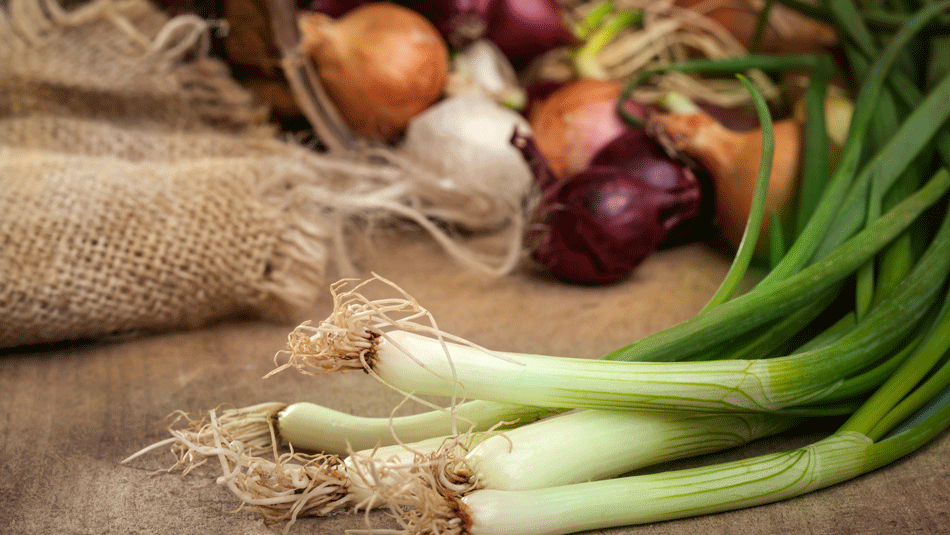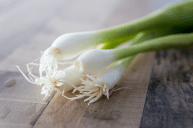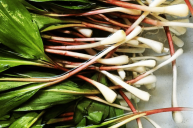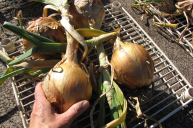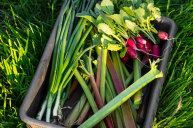If you've swung by the farmer's market lately, you may have noticed beautiful freshly cut flowers, gorgeous asparagus stalks, and delicate tender greens are all back in season. You may have also noticed a variety of green-colored onions that all kind of look the same, but have different names. Do your eyes deceive you? No, they do not. There is a world of confusion that surrounds spring alliums.
We know that leeks are the big ones, but what exactly is a chive? How are they any different than a green onion? And what about those scallions? Deciphering one from the rest, we created an easy spring alliums guide so you skip the head scratching and get down to the eating.
Green Onions & Scallions
You have probably noticed some confusion around the term green onion and scallions. From grocery stores to recipes, it would appear that these two are interchangeable, but are they the same thing? The answer is yes. Green onions and scallions are the exact same thing. Like different regions referring to carbonated soft drinks as soda or pop, the term chosen to refer to this allium is based upon geography.
What name you choose, however, doesn't change what this allium is. It's a slender versatile onion with a green top and a white base, lacking a bulb. The reason for this is they are either harvested as immature onions or they come from a separate cultivator than the bulb-forming onions. As far as flavor, these crunchy alliums tend to be more sweet and mild. They are often used in Mexican cuisine and taste great as a raw addition to dishes like tabouli. Next time you're at the farmer's market or store, pick some up and try them in your next meal.
Spring Onions
https://www.instagram.com/p/BiapiiZAsW1/?tagged=springonions
So if green onions and scallions are the same thing, what are spring onions? These guys are like scallions, or green onions if you prefer, except for one major difference: they contain a bulb. This is because they come from an allium bulb-forming variety of onion that is harvested before it grows into a large storage onion. When you're shopping for these, you'll find they have vibrant green tops with large white or red bulbs - color depends on the variety.
As far as its flavor, they are somewhat in the middle. They are more pungent than scallions or green onions, but are sweeter and more mild than say the red or yellow onions often used in cooking. They taste excellent grilled and paired with salsa and tortillas, a lemony grilled chicken, or tossed in stir-fries.
Chives
If you're a baked potato lover, you've probably eaten a chive or two. Thanks to their oniony, slight garlicky flavor, they are used like herbs or garnishes. A different species than spring onions and scallions, chives are in the species allium sphaerocephalo - which are also known as Drumstick Allium due to their shape.
Popping up like weeds, you know you have chives when a purple sensation of flower heads take over the garden plants. With a bloom time in late spring and early summer, these purple flowers are unlike ornamental onions because they are edible - and taste just like the stalk. If you're not sure how to utilize the whole thing, try chopping it all up and adding it to a fresh spring salad or sprinkle it on top of a bowl of cold green gazpacho.
Ramps
Something has happened in the culinary world that has sparked a ramp revolution. From farmer's markets to farm-to-table restaurant menus, ramps have popped up left and right. If you've ever eaten one, you understand why. Ramps, or wild leeks, taste like a pungent cross between onion and garlic. They can easily be identified by their broad green leaves and white bottoms.
Like spring onions, they are wonderful with a little bit of char from cooking on the outdoor grill. Pair them with a pesto or Romesco sauce for a terrific spring snack. You can even make a ramp pesto to top your charred ramps! They only last for a few days though once picked so use them up.
Leeks
Thanks to their large size, leeks are the easiest to distinguish amongst the rest. Looking like a giant scallion, they are milder than scallions with a sweet white base and a woodsy tasting stalk. Because of their hardy greens, they are best served cooked. Cooking will also mellow out their garlicky flavor. They pair well with seafood and make for a killer soup. Leeks can be very gritty, so take extra care when washing.
Now that we've settled some confusion, let us know how you like to use your favorite spring allium by commenting below.
